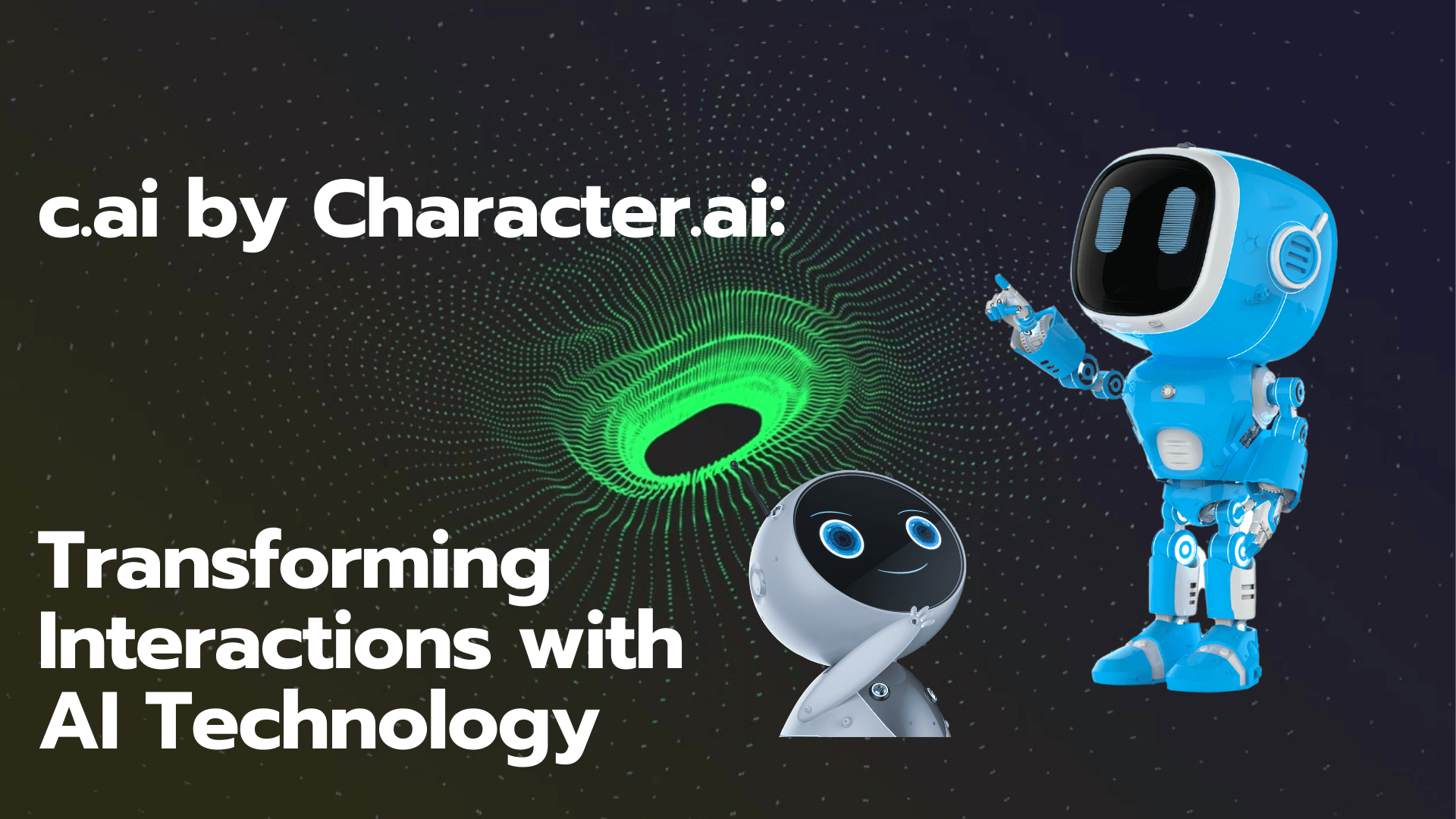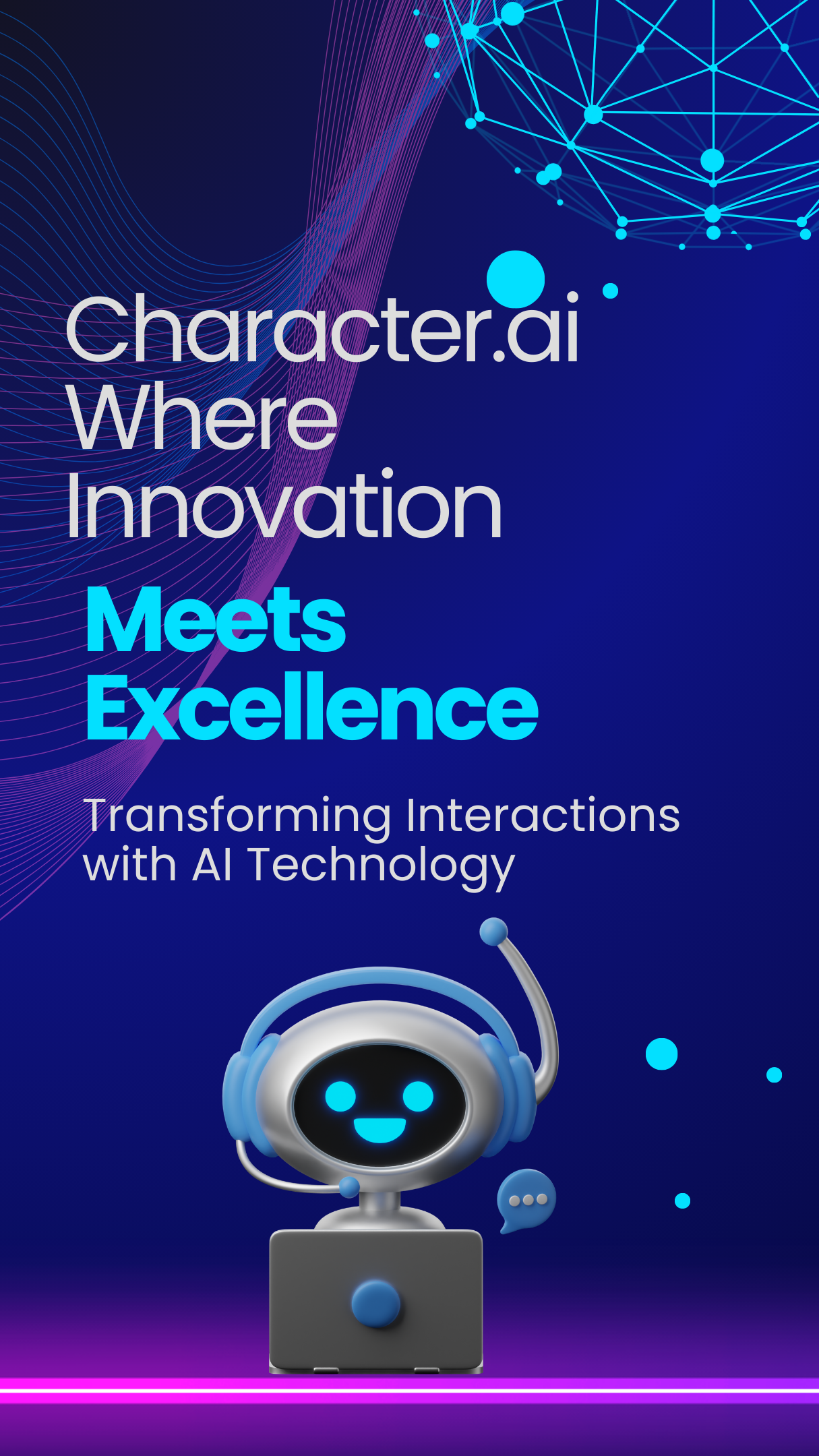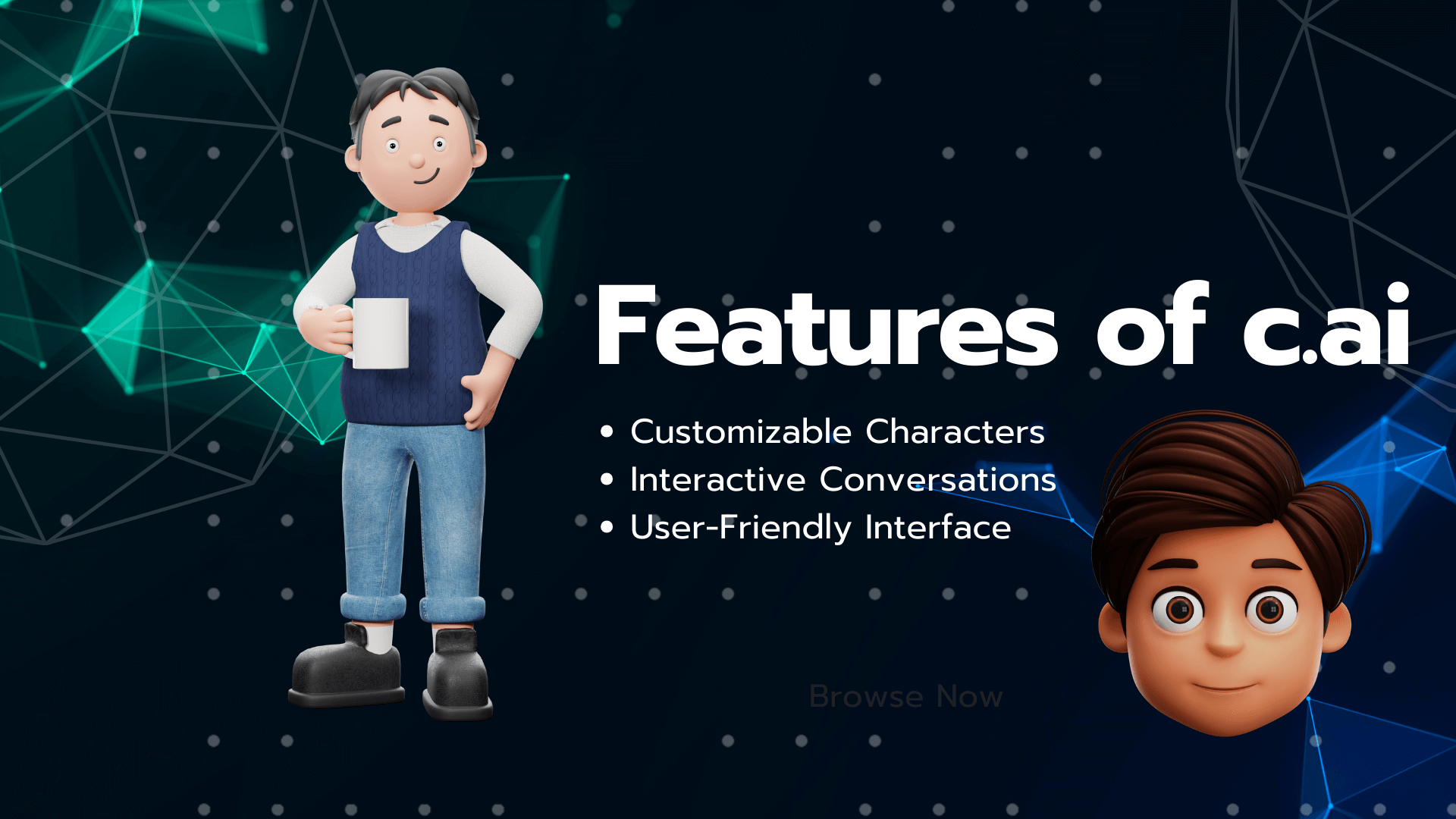Character.ai: Transforming Interactions with AI Technology
c.ai by Character.ai: Revolutionize digital interactions with AI-generated characters. Engage in natural, dynamic conversations for personalized and efficient experiences.

Character.ai, also known as c.ai, is a groundbreaking platform that enables users to create and interact with AI-generated characters. These characters are designed to engage in natural and dynamic conversations, providing a human-like interaction experience. In today's digital age, artificial intelligence plays a crucial role in enhancing user interactions across various platforms. c.ai leverages advanced AI technologies to revolutionize how we communicate with machines, making digital interactions more engaging, personalized, and efficient.
Table of Content
What is c.ai?
Historical Overview of AI Development
The Technology Behind c.ai
The Role of NLP in AI Interactions
Understanding AI Characters
Features of c.ai
Applications of c.ai
Impact of AI Characters in the Industry
Benefits of Using c.ai
Scalability of AI Solutions
Community and Collaboration
Getting Started with c.ai
Future of c.ai
Conclusion
Frequently Asked Questions (FAQs) about Character.ai
What is c.ai?
Definition and Purpose
c.ai stands for Character.ai, a platform focused on developing AI-driven characters that can interact with users in a natural, human-like manner. The primary goal of c.ai is to bridge the gap between technology and human interaction by providing tools that allow users to create personalized AI characters. These characters can serve multiple purposes, from virtual companions and educational tools to customer service representatives and entertainment figures. By offering a customizable and interactive experience, c.ai aims to make AI more accessible and beneficial for a wide range of applications.

Historical Overview of AI Development
Artificial Intelligence (AI) has a rich history dating back to ancient myths and legends, but its modern development began in earnest in the mid-20th century. The term "artificial intelligence" was coined by John McCarthy in 1956 during the Dartmouth Conference, marking the official birth of AI as an academic discipline. Early AI research focused on symbolic reasoning and problem-solving, leading to the development of the first AI programs capable of playing chess and solving algebraic equations.
Throughout the 1960s and 1970s, AI research was characterized by high expectations but limited by the computational power and theoretical understanding of the time. The field saw significant advancements with the development of expert systems in the 1980s, which used rule-based approaches to simulate human expertise in specific domains such as medical diagnosis and financial forecasting.
Key Milestones in AI Technology
The late 20th and early 21st centuries witnessed several key milestones that propelled AI forward. One such milestone was the advent of machine learning, a paradigm shift from rule-based systems to algorithms that learn from data. The development of neural networks, inspired by the human brain's structure, enabled significant improvements in tasks such as image recognition and natural language processing.
In 1997, IBM's Deep Blue defeated world chess champion Garry Kasparov, showcasing the potential of AI to outperform human experts in specific tasks. This was followed by the success of IBM's Watson in winning the game show "Jeopardy!" in 2011, demonstrating AI's ability to understand and process natural language.
The introduction of deep learning in the 2010s, characterized by multi-layered neural networks, further revolutionized AI. Techniques such as convolutional neural networks (CNNs) and recurrent neural networks (RNNs) achieved unprecedented accuracy in image and speech recognition, leading to the widespread adoption of AI in various industries.

The Technology Behind c.ai
-
Natural Language Processing (NLP)
Natural Language Processing (NLP) is a subfield of artificial intelligence that focuses on the interaction between computers and humans through natural language. NLP enables machines to understand, interpret, and generate human language. In the context of c.ai, NLP is used to ensure that AI characters can comprehend user inputs and respond in a contextually appropriate manner. This involves complex processes such as syntactic and semantic analysis, sentiment analysis, and language generation, all of which contribute to making interactions with AI characters feel more natural and fluid. -
Machine Learning Algorithms
Machine learning algorithms are at the heart of c.ai's functionality. These algorithms allow AI characters to learn from interactions and improve over time. By analyzing vast amounts of data, machine learning models can identify patterns, make predictions, and adapt to new information. In c.ai, machine learning enables characters to understand user preferences, recall previous interactions, and provide more personalized responses. Different types of algorithms, such as supervised learning, unsupervised learning, and reinforcement learning, are employed to enhance the capabilities of AI characters. -
Artificial Intelligence Integration
The integration of artificial intelligence in c.ai involves combining various AI technologies to create a cohesive and functional system. This includes integrating NLP and machine learning with other AI components such as speech recognition, voice synthesis, and computer vision. The seamless integration of these technologies ensures that AI characters can interact with users in a multimodal manner, whether through text, voice, or visual cues. This holistic approach to AI integration is what sets c.ai apart, providing users with a rich and immersive interaction experience.
The Role of NLP in AI Interactions
NLP Techniques Used in c.ai
c.ai leverages advanced NLP techniques to create AI characters capable of engaging in natural and dynamic conversations. These techniques include syntactic and semantic analysis, which help the AI understand the structure and meaning of user inputs. Syntactic analysis involves parsing sentences to identify grammatical relationships, while semantic analysis focuses on extracting the underlying meaning of the text.
Sentiment analysis is another crucial NLP technique used in c.ai. It enables the AI to detect the user's emotions and respond appropriately. For example, if a user expresses frustration, the AI can provide empathetic responses to address their concerns.
Language generation is an essential aspect of NLP in c.ai. Using techniques such as sequence-to-sequence models and transformers, the AI can generate coherent and contextually relevant responses. This allows the AI characters to maintain engaging and meaningful conversations with users.
Understanding AI Characters
How AI Characters are Created
Creating AI characters involves several steps, from conceptual design to technical implementation. The process begins with defining the character's purpose and role. For example, a virtual assistant designed to handle customer inquiries will have different requirements compared to an AI tutor for educational purposes.
Once the purpose is defined, the character's personality and traits are designed. This includes developing a backstory, conversational style, and visual appearance. Designers use tools such as scripting languages and graphic design software to create a coherent and engaging character profile.
The Science Behind AI Personalities
The personality of an AI character is shaped by a combination of natural language processing (NLP) and machine learning algorithms. NLP enables the AI to understand and generate human language, making interactions more natural and contextually relevant. Techniques such as sentiment analysis and entity recognition help the AI comprehend the user's emotions and identify key information within the conversation.
Machine learning algorithms allow the AI to learn from interactions and improve over time. By analyzing user inputs and feedback, the AI can adapt its responses to better match user preferences and expectations. This continuous learning process ensures that the AI character remains engaging and relevant.

Features of c.ai
-
Customizable Characters
One of the standout features of c.ai is the ability to create highly customizable characters. Users can design characters with unique personalities, backstories, and conversational styles. This customization extends to visual appearance, voice, and even specific behavior patterns. By allowing users to tailor characters to their specific needs and preferences, c.ai ensures that each interaction is unique and engaging. This feature is particularly valuable for businesses looking to create branded virtual assistants or for individuals seeking personalized virtual companions. -
Interactive Conversations
c.ai characters are designed to engage users in ongoing, evolving conversations. Unlike traditional chatbots with scripted responses, c.ai characters can handle complex dialogues, remember past interactions, and adapt to new information. This dynamic interaction capability makes conversations with AI characters feel more natural and less mechanical. For example, a virtual assistant created with c.ai can remember a user's previous inquiries and preferences, providing more relevant and personalized responses in future interactions. -
User-Friendly Interface
The user-friendly interface of c.ai makes it accessible to both developers and general users. The platform provides intuitive tools and features that simplify the process of creating and managing AI characters. This includes drag-and-drop character design, easy-to-use scripting tools, and comprehensive tutorials. By lowering the barrier to entry, c.ai enables more people to leverage the power of AI, whether for personal use, business applications, or creative projects.
Applications of c.ai
-
Entertainment
In the entertainment industry, c.ai opens up new possibilities for creating interactive experiences. Role-playing games can benefit from AI-driven characters that adapt to player behavior and enhance the storyline. Storytellers can use c.ai to create dynamic narratives where characters interact with the audience, making the experience more immersive. Virtual companions powered by c.ai can provide entertainment and companionship, engaging users in meaningful conversations and activities. -
Education
Educational applications of c.ai are vast and impactful. AI characters can serve as tutors, providing personalized lessons and feedback to students. Educational bots can engage learners in interactive dialogues, making learning more engaging and effective. For instance, a language learning app can use c.ai characters to simulate real-life conversations, helping students practice and improve their language skills in a more natural setting. -
Customer Service
In customer service, c.ai characters can act as virtual assistants, handling inquiries, providing information, and resolving issues. These AI-driven customer service representatives can operate 24/7, ensuring that customers receive timely assistance. By automating routine tasks, businesses can improve efficiency and reduce operational costs. Moreover, the personalized interaction capabilities of c.ai characters enhance customer satisfaction by providing tailored responses based on individual customer profiles.
Impact of AI Characters in the Industry
AI in Gaming and Storytelling
AI has had a significant impact on the entertainment industry, particularly in gaming and storytelling. In the gaming industry, AI is used to create intelligent and adaptive characters that enhance the gameplay experience. AI-driven characters can respond to player actions, adapt to different strategies, and create dynamic and immersive game worlds.
One notable example is the use of AI in role-playing games (RPGs). AI characters can interact with players in meaningful ways, providing unique dialogues, quests, and storylines. This creates a more engaging and personalized gaming experience, as players feel their actions have a direct impact on the game world.
In storytelling, AI is used to create dynamic narratives where characters interact with the audience. AI-driven characters can respond to user inputs and make real-time adjustments to the story, creating an interactive and immersive experience. This approach is used in various forms of entertainment, from interactive movies and TV shows to virtual reality experiences.
Future Trends in AI-Driven Entertainment
The future of AI-driven entertainment holds exciting possibilities, with advancements in AI technology enabling more sophisticated and immersive experiences. One emerging trend is the use of AI to create personalized content, where AI characters can tailor their interactions and storylines to individual users. This can enhance user engagement and satisfaction, as the content feels more relevant and meaningful.
Another trend is the integration of AI with virtual and augmented reality. AI characters can interact with users in a 3D environment, providing a more immersive and interactive experience. This approach is being explored in various forms of entertainment, from gaming and storytelling to virtual concerts and live events.
The use of AI in content creation is also on the rise, with AI algorithms capable of generating music, art, and even scripts. This can streamline the creative process and enable new forms of artistic expression. AI-driven content creation tools are becoming more accessible, allowing artists and creators to leverage AI in their work.
Educational Benefits of AI Characters
AI as Personalized Tutors
AI characters can serve as personalized tutors, providing tailored lessons and feedback to students. Using advanced NLP and machine learning techniques, AI tutors can understand the student's progress and adapt their teaching methods accordingly. This personalized approach enhances the learning experience, making it more engaging and effective.
For example, an AI tutor in a language learning app can provide customized practice exercises based on the student's proficiency level. The AI can offer real-time feedback, correct mistakes, and provide explanations, helping the student improve their skills more quickly. This personalized approach helps students stay motivated and achieve better outcomes.
Enhancing Learning Experiences with AI
AI characters can enhance learning experiences by making education more interactive and engaging. AI-driven educational tools can simulate real-life scenarios, allowing students to practice and apply their knowledge in a safe and controlled environment. This hands-on approach to learning helps students develop critical thinking and problem-solving skills.
For instance, an AI-powered chemistry tutor can guide students through virtual experiments, explaining complex concepts and providing instant feedback. This interactive approach makes learning more enjoyable and helps students grasp difficult concepts more easily.
AI characters can also support collaborative learning, where students work together on projects and assignments. AI-driven tools can facilitate communication and collaboration, providing guidance and feedback to the group. This approach fosters teamwork and enhances the overall learning experience.
AI in Customer Service
Improving Customer Support with AI
AI characters can significantly improve customer support by handling inquiries, providing information, and resolving issues. AI-driven virtual assistants can operate 24/7, ensuring that customers receive timely assistance. By automating routine tasks, businesses can improve efficiency and reduce operational costs.
AI characters can handle a wide range of customer inquiries, from answering frequently asked questions to processing orders and tracking shipments. Using advanced NLP techniques, the AI can understand and respond to customer inputs in a natural and contextually relevant manner. This enhances the overall customer experience and increases satisfaction.
Case Studies: Successful AI Customer Service Implementations
Many businesses have successfully implemented AI in their customer service operations, achieving significant improvements in efficiency and customer satisfaction. One notable example is the use of AI-powered chatbots in e-commerce. These chatbots can handle customer inquiries, process orders, and provide personalized product recommendations, enhancing the shopping experience.
In the banking industry, AI-driven virtual assistants are used to handle customer inquiries and provide financial advice. These AI characters can assist with tasks such as checking account balances, transferring funds, and offering investment recommendations. By providing instant and accurate assistance, AI virtual assistants improve the overall customer experience and reduce the workload on human agents.
The healthcare industry has also seen successful AI implementations, with AI-powered virtual assistants used to provide medical information and support. These AI characters can handle inquiries about symptoms, medications, and treatments, providing timely and accurate information to patients. This improves patient satisfaction and reduces the burden on healthcare professionals.
Efficiency Gains from AI Automation
Automating Routine Tasks with AI
AI automation can significantly improve efficiency by automating routine and repetitive tasks. In customer service, for example, AI characters can handle common inquiries, freeing up human agents to focus on more complex issues. This reduces wait times and enhances the overall customer experience.
In educational settings, AI tutors can provide instant feedback and support, allowing educators to manage larger classes more effectively.
The AI can handle tasks such as grading assignments, providing explanations, and answering questions, streamlining the teaching process and improving efficiency.
AI automation is also used in various other industries, from manufacturing and logistics to healthcare and finance. By automating tasks such as data entry, inventory management, and transaction processing, businesses can improve efficiency and reduce operational costs.
Cost Savings and Efficiency Improvements
The automation capabilities of AI translate to significant cost savings for businesses and institutions. By reducing the need for human labor in routine tasks, AI can lower operational costs and increase profitability. This is particularly important in industries with high labor costs, such as customer service and healthcare.
In addition to cost savings, AI automation can improve efficiency by streamlining workflows and reducing errors. AI characters can handle tasks more quickly and accurately than humans, enhancing productivity and quality. This leads to better outcomes and increased customer satisfaction.
AI-driven automation also provides scalability, allowing businesses to handle larger volumes of work without a corresponding increase in labor costs. This is particularly important for growing businesses that need to expand their operations while maintaining efficiency and profitability.
Benefits of Using c.ai
-
Enhanced User Experience
One of the primary benefits of using c.ai is the enhanced user experience. By providing natural and engaging interactions, c.ai characters keep users more engaged and satisfied. This is particularly important in customer service and educational applications, where user engagement directly impacts outcomes. Real-world examples and case studies demonstrate how c.ai has improved user experiences across various industries, from reducing wait times in customer service to increasing student engagement in online learning platforms. -
Increased Efficiency
c.ai also boosts efficiency by automating repetitive tasks and streamlining workflows. In customer service, for example, AI characters can handle common inquiries, freeing up human agents to focus on more complex issues. In educational settings, AI tutors can provide instant feedback and support, allowing educators to manage larger classes more effectively. The automation capabilities of c.ai translate to significant time and cost savings for businesses and institutions.
Scalability of AI Solutions
Scaling AI for Small to Large Applications
The scalability of AI solutions is a significant advantage, allowing businesses and institutions to adapt AI to different needs and scales. c.ai provides a versatile platform that can be used for small personal projects or large enterprise applications.
For small projects, users can start with a basic virtual assistant and gradually expand its capabilities as needed. This allows individuals and small businesses to leverage the power of AI without a significant upfront investment. As the project grows, additional features and functionalities can be added to meet increasing demands.
For large enterprise applications, c.ai provides robust tools and infrastructure to support complex and high-volume operations. Businesses can deploy AI characters across multiple departments and functions, from customer service and sales to marketing and support. This scalability ensures that the AI solution can grow with the business, providing consistent performance and value.
Examples of Scalable AI Implementations
Many businesses and institutions have successfully scaled their AI implementations to meet their specific needs. For example, a retail company can start with an AI-powered chatbot to handle customer inquiries and gradually expand its capabilities to include personalized product recommendations and order processing. As the business grows, the AI solution can be scaled to handle higher volumes of customer interactions and provide more advanced features.
In the education sector, an online learning platform can start with a basic AI tutor to provide personalized lessons and feedback. As the platform grows, additional AI-driven tools can be added, such as virtual classrooms, collaborative learning environments, and advanced analytics. This scalability ensures that the platform can accommodate more students and provide a richer learning experience.
In the healthcare industry, a medical practice can start with an AI-powered virtual assistant to handle patient inquiries and appointment scheduling. As the practice grows, the AI solution can be expanded to include features such as telemedicine, remote patient monitoring, and personalized treatment recommendations. This scalability ensures that the practice can provide high-quality care to more patients while maintaining efficiency and effectiveness.
Community and Collaboration
-
Sharing and Collaboration Features
c.ai fosters a collaborative community where users can share their characters and creations. This feature allows users to exchange ideas, learn from each other, and collaborate on projects. The community-driven approach to character development encourages innovation and creativity, as users can build upon each other's work and contribute to the collective knowledge base. -
Success Stories
Highlighting notable characters and success stories is an essential part of showcasing the potential of c.ai. Users have created a wide variety of characters, from educational bots that have improved student outcomes to virtual assistants that have streamlined customer service operations. Testimonials and experiences from these users provide valuable insights and inspiration for others looking to explore the possibilities of c.ai.
Getting Started with c.ai
-
Step-by-Step Guide
To help new users get started with c.ai, a step-by-step guide is essential. This guide covers the basics of creating an account on Character.ai, navigating the platform, and designing your first character. Detailed instructions and screenshots can make the onboarding process smoother and more accessible. -
Tips and Tricks
Providing tips and tricks for character customization and interaction can help users maximize the potential of c.ai. This section can include best practices for designing engaging characters, optimizing conversations, and leveraging advanced features. Practical advice from experienced users can make the learning curve less steep and enhance the overall user experience.
Future of c.ai
-
Upcoming Features and Updates
Looking ahead, c.ai has a roadmap of upcoming features and updates designed to enhance its capabilities and user experience. This section can provide a sneak peek into what's next for Character.ai, including planned improvements, new tools, and innovative features. Keeping users informed about future developments helps maintain their interest and engagement. -
The Evolving Role of AI in Interactions
The future of AI and digital interactions is continuously evolving, and c.ai is at the forefront of this transformation. Predictions for the future of AI highlight the increasing role of AI in everyday interactions, from personal assistants to professional tools. By exploring these trends and how c.ai is leading the way, users can gain a deeper understanding of the platform's potential and long-term impact.
Conclusion
Character.ai, or c.ai, represents a groundbreaking advancement in AI technology, offering users the ability to create and interact with AI-generated characters in a natural, human-like manner. This platform is designed to bridge the gap between technology and human interaction, making digital communications more engaging, personalized, and efficient.
With its extensive customization options, c.ai allows users to design characters with unique personalities, appearances, and behaviors, catering to a wide range of applications from virtual companions and educational tools to customer service representatives and entertainment figures. The advanced AI technologies, including Natural Language Processing (NLP) and machine learning algorithms, ensure that these characters can understand, interpret, and respond to user inputs contextually and appropriately, continuously learning and improving over time.
The platform's scalability makes it adaptable for various needs and projects, whether for individual users, educational institutions, or large enterprises. Its integration capabilities allow seamless incorporation into existing systems, enhancing the functionality and interactivity of user applications.
c.ai also fosters a collaborative community, encouraging users to share their creations, exchange ideas, and collaborate on projects. This community-driven approach promotes innovation and creativity, contributing to the collective advancement of AI technology.
Looking ahead, Character.ai is committed to continuous improvement and innovation, with plans to introduce new features and updates that will further enhance its capabilities and user experience. As AI technology continues to evolve, c.ai is poised to play a pivotal role in shaping the future of digital interactions, making AI more accessible and beneficial across various domains.
In conclusion, Character.ai offers a transformative solution for creating and interacting with AI-driven characters, providing a rich and immersive interaction experience that is both engaging and efficient. Whether for personal use, educational purposes, or business applications, c.ai empowers users to leverage the power of AI, paving the way for more natural and dynamic digital communications. Explore Character.ai today and join the growing community of innovators who are shaping the future of AI-driven interactions.
Frequently Asked Questions (FAQs) about Character.ai
1. Can c.ai AI characters simulate emotions and empathy?
Character.ai AI characters are designed to exhibit empathy and simulate emotions to a certain extent. They can recognize emotional cues in user input through sentiment analysis and respond accordingly, providing a more human-like interaction experience.
2. Who can use c.ai?
c.ai is designed for a wide range of users, including individuals, educators, businesses, and developers. Whether you want to create a virtual companion, an educational tool, a customer service representative, or an entertainment figure, c.ai provides the tools and resources you need.
3. How do I get started with c.ai?
To get started, you need to create an account on the Character.ai platform. Once registered, you can access the character creation tools, design your AI characters, and start interacting with them. The platform provides tutorials and documentation to help you through the process.
Technical Questions
4. What technologies does c.ai use?
c.ai leverages advanced artificial intelligence technologies, including Natural Language Processing (NLP), machine learning algorithms, and speech recognition. These technologies enable the AI characters to understand, interpret, and respond to user inputs in a natural and contextually appropriate manner.
5. Can I customize my AI characters?
Yes, c.ai allows extensive customization of AI characters. You can design their appearance, voice, personality, and behavior. The platform provides drag-and-drop design tools and intuitive scripting features to help you create unique and engaging characters.
6. How does c.ai ensure the privacy and security of user data?
c.ai takes privacy and security seriously. The platform uses encryption and other security measures to protect user data. Additionally, c.ai adheres to data protection regulations and provides users with control over their data and privacy settings.
Application and Usage
7. What are some common applications of c.ai?
c.ai can be used in various applications, including:
Entertainment: Creating interactive characters for games, storytelling, and virtual companions.
Education: Developing AI tutors for personalized learning and educational bots.
Customer Service: Implementing virtual assistants to handle customer inquiries and provide support.
Marketing and Sales: Creating AI characters for engaging and personalized customer interactions.
8. Can c.ai be integrated with other platforms and systems?
Yes, c.ai provides APIs and integration tools that allow you to incorporate AI characters into your existing platforms and systems. This makes it easy to enhance your applications with AI-driven interactions.
9. How do AI characters learn and improve over time?
AI characters use machine learning algorithms to learn from interactions and improve over time. They analyze user inputs, identify patterns, and adapt to new information. This continuous learning process helps them provide more personalized and relevant responses.
Community and Support
10. Is there a community where I can share my creations and collaborate with others?
Yes, c.ai fosters a collaborative community where users can share their characters, exchange ideas, and collaborate on projects. The platform provides forums and discussion groups where users can connect, learn from each other, and contribute to the community.
11. What kind of support does c.ai offer to users?
c.ai offers various support resources, including comprehensive documentation, tutorials, and user guides. Additionally, the platform provides customer support to assist with technical issues and answer any questions you may have.
12. Are there any costs associated with using c.ai?
c.ai offers different pricing plans, including free and paid options. The free plan provides access to basic features, while the paid plans offer additional capabilities and resources for more advanced and large-scale projects. You can choose a plan that best suits your needs and budget.
Future Developments
13. What new features and updates can we expect from c.ai in the future?
c.ai is continuously evolving, with plans to introduce new features and updates to enhance its capabilities and user experience. Upcoming developments may include advanced customization options, improved AI algorithms, and new integration tools. Users can stay informed about future updates through the platform's announcements and newsletters.
14. How is c.ai contributing to the future of AI and digital interactions?
c.ai is at the forefront of AI and digital interactions, pioneering new ways for humans to interact with machines. By advancing AI technologies and making them accessible, c.ai is helping to shape the future of AI, enabling more natural, engaging, and personalized interactions across various domains.
15. How does c.ai handle multiple languages and accents?
c.ai supports multiple languages and accents through its Natural Language Processing (NLP) capabilities. AI characters can understand and respond in different languages and accents, enhancing their versatility and usability in global applications.
16. What kind of analytics and reporting does c.ai provide?
c.ai provides analytics and reporting tools that enable users to track interactions, analyze user behavior, and measure the performance of AI characters. This data helps in optimizing character design, improving user engagement, and making informed decisions.
17. Can I use c.ai to create characters for VR (Virtual Reality) and AR (Augmented Reality) applications?
Yes, c.ai supports the creation of AI characters for VR and AR applications. These characters can interact with users in immersive environments, enhancing the overall experience of virtual and augmented reality experiences.


